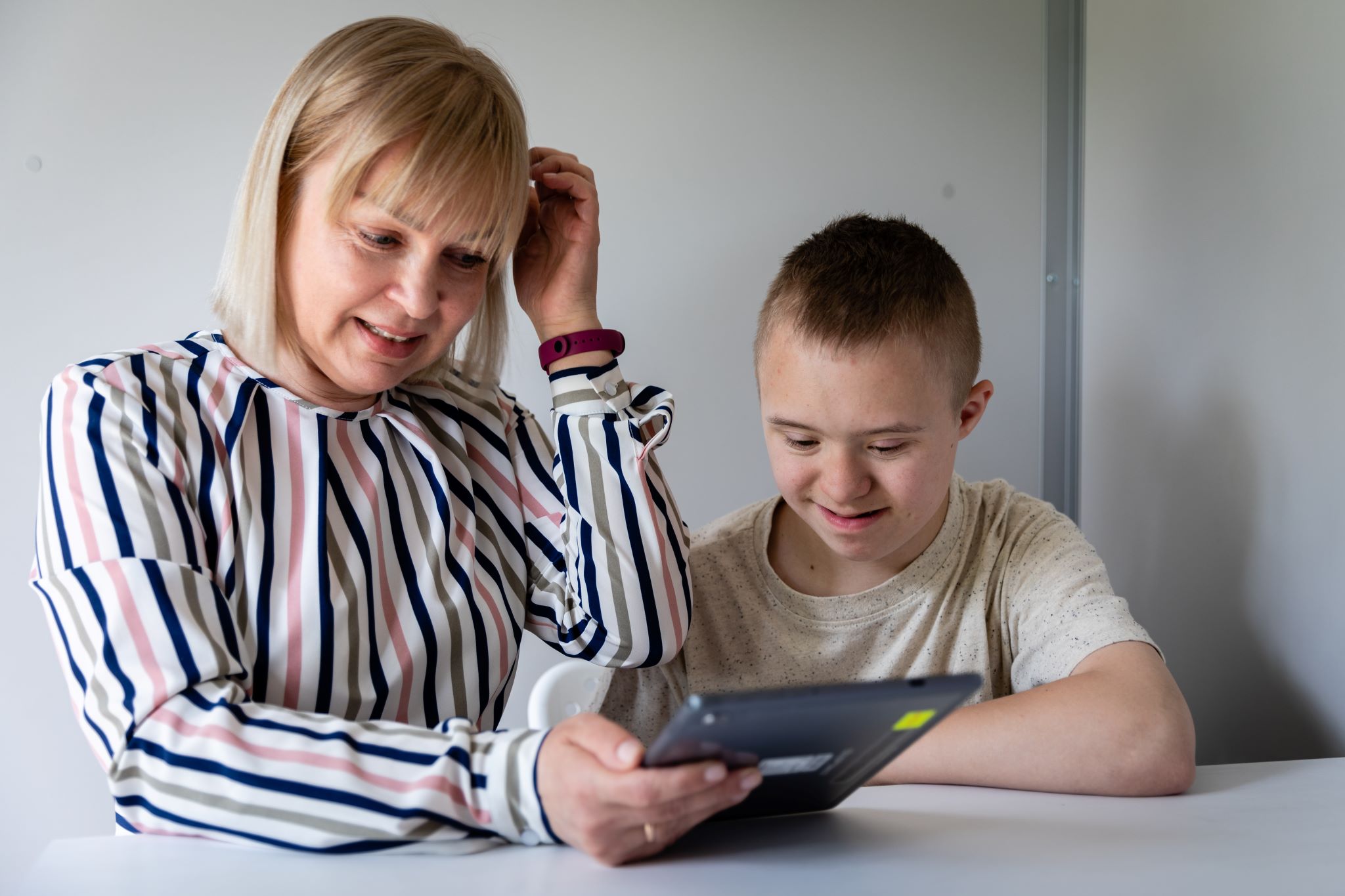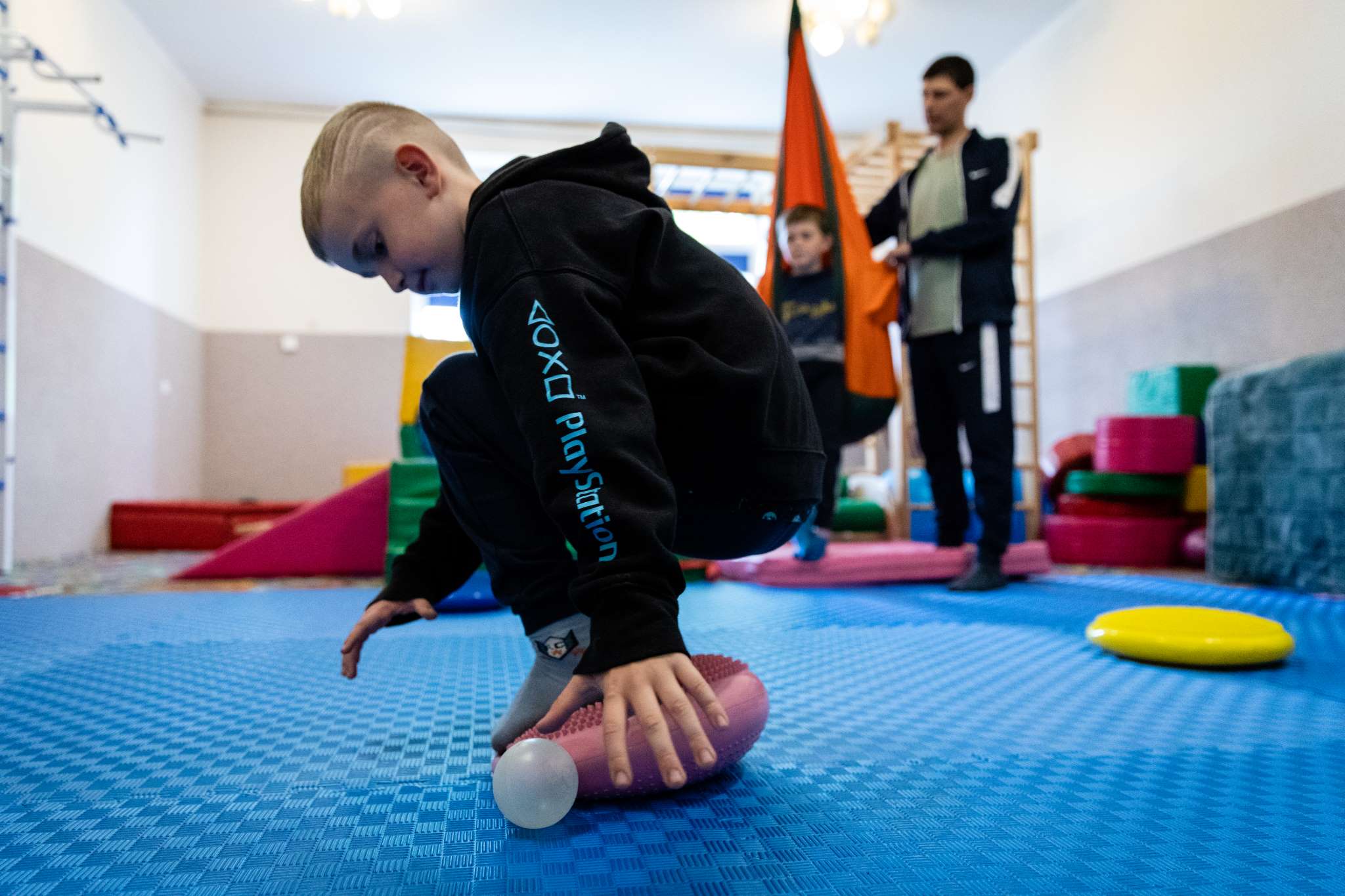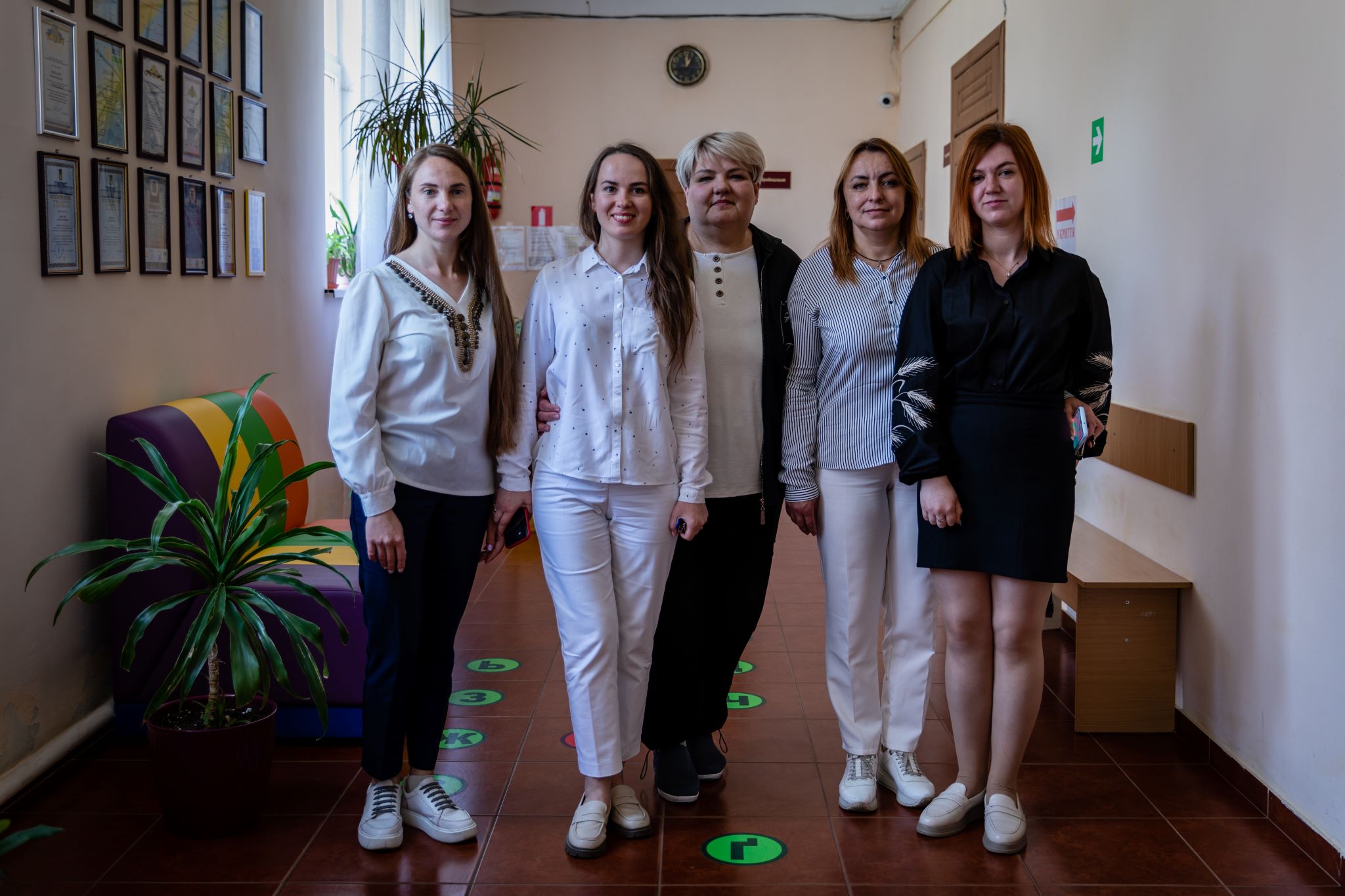Every child is special
How the St. Nicholas Education and Rehabilitation Center finds the right approach to everyone
The lowest windows of the building are barricaded with sandbags, behind them is a shelter. The St. Nicholas Center is getting used to life amid the ongoing war. This institution has taken in 18 children from IDP families and is now setting up its summer camp to welcome another 50 kids from the Kherson region.
“The war has further complicated the already difficult life of our students,” the center’s personnel explain.
The St. Nicholas Education and Rehabilitation Center received assistance from the Alliance for Public Health with the support of Payoneer. The center was included in the list of 18 institutions that take care of children with disabilities. In 2023, together with the Ministry of Social Policy, the Alliance identified a list of families and schools that needed support as a top priority.
Fantasies made from sand
“Marichka, will you draw a sun for me?” asks the teacher, Ms. Nataliia.
The kid’s fingers draw a circle with the sun’s rays around it.
“What emotions is the sun feeling?”
Marichka adds in a little line – now the sun is smiling. After offering greetings, it’s time to wave it bye-bye and say “See you later!”
With one flick of the hand, the sand therapy table becomes a blank canvas, ready to be filled with new drawings. It seems like a fun game, but this is how the lessons with the speech therapist begin.
The table has a backlight and the kid has a say in choosing the light color. The teacher takes out two cards that show a watermelon and a bar of soap.
“What does watermelon taste like? What color are its seeds? What can soap smell like?” Natalia asks.
“A bar of soap can smell like watermelon!” Marichka exclaims.
Drawing in the sand is both learning and therapy
All sessions are conducted in game format. The teacher places cubes with alphabet letters into the sand and Marichka has to make words out of them. She hides figures of animals in the sand and the kid has to take them out, name them, and write the first and last letter of each word in the sand. This activity helps kids learn letters and practice pronouncing relevant sounds.
“Normally, the child would have lost focus and concentration a long time ago if I had just told her some things from the textbook,” the teacher comments. “This therapy requires a special approach. Marichka is so enthusiastic about sand drawing that there’s simply no time for her to get bored.”
Iryna Lukachuk, Deputy Principal for Academic Affairs, recalls that back when sand therapy tables were not a thing, they put together similar constructions on their own, for example, using empty candy boxes and colored rice.
“Normally, the child would have lost focus and concentration a long time ago if I had just told her some things from the textbook,” the teacher comments. “This therapy requires a special approach. Marichka is so enthusiastic about sand drawing that there’s simply no time for her to get bored.”
A computer tablet that helps to better communicate with others
The center’s grounds have space for stables and therapeutic horse riding (equine-assisted therapy) for kids. There is a small greenhouse in the yard where children grow vegetables. However, there is not enough space for classrooms: 300 kids are accommodated in small groups of up to six people, while some of them have one-on-one sessions with specialists.
Modular structures are currently used as a makeshift solution. In them, teachers can work individually with their charges.
In the beanbag chair sits a boy with a sensory bag wrapped around him. It provides a safe space for the child to hide in. In addition, this also helps him develop an awareness of space. Once the kid has regained his strength, he goes on to do some balance beam activities.
A boy in a sensory bag exercising on a balance beam
“Different areas of the brain are activated when a child is exercising on the balance beam, and this has a positive effect on their overall development,” says Natalia Biletska, Deputy Principal of the School for Experimental Education and Methodology. “It is easier to learn a rhyme or memorize a fact while standing on a balance beam.
Tetiana Muryn, a psychologist, sits at the desk with her student, Artem. The boy’s condition makes it difficult for him to speak, but when armed with the tablet he can express anything he wants to express.
“What would you like?” Tatiana asks Artem.
He picks out his answer from the card and presses the button. “To have good healthy teeth” is his choice.
Artem can also tell or ask something himself by selecting the appropriate button. Apart from this, he can send a message to his parents or teachers. “I did the assignment” is the text of the message he sent to his teacher.

Psychologist Tetiana Muryn uses the program with voice-activated buttons to engage with her student Artem in session
The app that allows such communication was developed in the United States. Representatives of the Lviv-based NGO Govory (Speak) obtained a license from the developers to use it and had it translated into Ukrainian.
“Tablets increase kids’ motivation to learn: you can download pictures relevant to a specific topic that a particular student likes,” says Tatiana Muryn. “And the sound software makes lessons more comfortable for the kids. With the press of a button, a student can signal that he or she needs a break or has to go to the bathroom.”
Meanwhile, in the adjacent room, an alternative communication session is underway. The topic in focus is hygiene. The teacher lays out a toy bathtub, animal figures, and a sponge in front of the student. She promises a surprise at the end: if the boy achieves all the objectives of the scheduled activities, he will get soap bubbles. They open a folder on the tablet with the desired topic and, looking at the picture on the screen, repeat the steps according to the algorithm provided. The boy has to wash the toys, while training his concentration and fine motor skills.
The Alliance for Public Health, with the support of Payoneer, purchased training and rehabilitation equipment for the center. The inventory of equipment acquired includes tablets, a balancing hemisphere and board, a sensory bag, a hug machine, a massage mat, a sensory track, a weighted vest and leg pads, finger exercisers, a sand therapy table, sound recording buttons, a pillow for sensory integration, and more.
The buttons with the sound recording feature are a helpful tool for speech therapists. The students use them to record how they pronounce certain words on a given topic: shorts, jacket, cap.
“It’s essential that children train their auditory perception skills, learn how to recognize and distinguish speech sounds,” says the teacher. “Kids love these buttons: they record songs, jump, and listen”.
Physical exercises that heal
In the gym, a teenage boy is standing on the balance beam, a machine that helps you learn how to feel your body in space. He does balance beam exercises and then walks over to the massage mat. First, he does some exercises with the dumbbells and then heads for the pull-up bar. Next in line!
“The boys train in a circuit-style format, doing different routines so that the exercise session is not so boring and monotonous,” says Taras Hryhorovych, a physical therapy teacher. “We use a balance beam to help the boys develop their balance and spatial orientation skills.”
The greatest feat here is to not lose your grip while holding on to a large sensory ball. Hovering nearby, Taras Hryhorovych acts as a “spotter” for safety to make sure no one gets injured.
Physical therapy session for senior grade students
“It’s essential that children train their auditory perception skills, learn how to recognize and distinguish speech sounds,” says the teacher. “Kids love these buttons: they record songs, jump, and listen”.
Taras Hryhorovych shows off the medals won by his students at the regional field and track competitions that were held among the education and rehabilitation centers.
The physical therapy class for the younger group is also underway. A student is trying to stay the distance on the balancing disks. The teacher says that this equipment is useful for children with Autism Spectrum Disorder: it helps the kids strengthen their muscles, as well as develop coordination and balance. For the same purpose, the boy is now doing exercises in a weighted vest and with leg pads on.

Balancing disks improve coordination and strengthen muscles
The teacher constantly cheers the boy on, calling him a champ.
“The child doesn’t feel comfortable in space, and exercises with weights help him feel grounded,” the teacher explains.
Nearby, a boy is swinging in a hanging nest swing.
“This nest swing helps you develop your balance and spatial orientation skills,” says Volodymyr, a rehabilitation teacher. “In it, kids feel comfortable and calm, their anxiety disappears, and their spirits are uplifted.”
The integral nest is effective for calming down and promoting development in children
The teacher pushes the boy on the swing, the boy smiles happily and raises his thumbs up.
The session also relies on the use of a hug machine squeezer, which is a training simulator with rollers. To get between them, the child has to put in an effort. The process develops their tactile sensations and improves the performance of the vestibular system (responsible for the body’s sense of balance, motion, and spatial orientation). By moving, children build up their balance and coordination skills. Their posture is improved as they straighten their arms and stretch their spines.
Children calm down as they feel their own body.
Things the war has complicated
The school does not have the usual bells for classes and recess. Children do not respond well to noise. Every air raid alert that entails the need for going down to the bomb shelter and staying in a cramped space causes stress in the students.
“After air raid alerts, our kids are worked up and agitated, and it’s harder for them to stay focused. The war is an additional traumatizing factor for them,” says Natalia Biletska. “It has further complicated the already difficult life of our students.”
Currently, 18 children from IDP families are enrolled in this center. In March 2022, it hosted orphans from the regions that are under threat of war.

Nataliia Tsymbalyuk, Principal (center) with her deputies. From left to right: Mariia Lozynska, Deputy Principal for Remedial Programs, Nataliia Biletska, Deputy Principal for Experimental Education and Methodology, Iryna Lukachuk, Deputy Principal for Academic Affairs, and Nadiia Plyska, Deputy Principal for Education
Despite the existing circumstances, the school is working at full capacity. Children are taught how to grow vegetables, plant flowers, master financial literacy, and learn about mine safety – knowledge that is relevant to the real-world context. The focus of the learning process is on helping them in finding their place in the world.
A few years ago, the center established collaboration with vocational colleges: before choosing a trade or profession, students have the opportunity to join classes and adapt to the new environment. Previously, teachers were wary of such partnerships, but now this has become commonplace. A school bus takes senior grade students to colleges where they can continue their education.
School athletes with a coach
Report by Yaroslava Tymoshchuk
photos by Katya Moskalyuk
